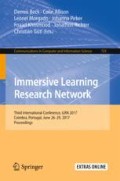Abstract
This paper describes an approach for to make available different experiences for learning using a 3D immersive world called AVATAR. It is based on a case study aimed to create virtual laboratories to assist in science learning and teaching. AVATAR has been designed for following the experiential learning and other relevant educational theories, initially focused on electricity basic principles. In order to validate this approach, a group of 32 users experienced the laboratories and answered a questionnaire aimed at assessing the affordances of these immersive environments. The analysis of the questionnaire answers has provided consistent results that will assist in the improvement and development of new experiments in the virtual world.
References
Achumba, I.E., Azzi, D., Dunn, V.L., Chukwudebe, A.: Intelligent performance assessment of students’s laboratory work in a virtual laboratory environment. IEEE Trans. Learn. Technol. 6(2), 103–116 (2013)
White, M.: Developing Environmental Sustainability Criteria for University Research Laboratories: A Tool for Rating and Implementing Green Methodology in Labs. Environmental Studies Undergraduate Student Theses. University of Nebraska, Lincoln, 22 p. (2012)
Piaget, J.: The Principles of Genetic Epistemology. Routledge & Kegan Paul, London (1972)
Kolb, D.: Experiential Learning: Experience as the Source of Learning and Development. Prentice Hall, Englewood Cliffs (1984)
Kolb, D., Boyatziz, R., Manemelis, C.: Experiential learning theory: previous research and new directions. In: Sternberg, R., Zhang, L. (eds.) Perspectives on Thinking, Learning, and Cognitive Styles. Routledge, New York (2011)
Ausubel, D.: The Acquisition and Retention of Knowledge: A Cognitive View. Kluwer Academic Publishers, Boston (2000)
Childs, M., Peachey, A. (eds.): Understanding Learning in Virtual Worlds, 1st edn., 179 p. Springer, London (2013)
Marsh, T., Yang, K., Shahabi, C.: Vicariously there: connected with and through our own and other characters. In: AISB 2005 Convention: Social Intelligence and Interaction in Animals, Robots and Agents, pp. 115–121 (2005)
Occhioni, M.: Techland, a virtual world for maths and science. In: Proceedings of the 3rd European Immersive Education Summit, London, pp. 94–99 (2013)
Thomas, M.J.W.: Operational fidelity in simulation-based training: the use of data from threat and error management analysis in instructional systems design. In: Proceedings of SimTecT2003: Simulation Conference, pp. 91–95 (2003)
Herrington, J., Reeves, T.C., Oliver, R.: Immersive learning technologies: realism and online authentic learning. J. Comput. High. Educ. 19(1), 80–99 (2007)
Dawley, L., Dede, C.: Situated learning in virtual worlds and immersive simulations. In: Spector, J.M., Merril, M.D., Elen, J., Bishop, M.J. (eds.) Handbook of Research on Educational Communications and Technology, pp. 723–734. Springer, New York (2014)
Petrakou, A.: Interacting through avatars: virtual worlds as a context for online education. Comput. Educ. 54(4), 1020–1027 (2010)
Berger, S.: Virtual 3D World for Physics Experiments in Higher Education. Thesis Graz University of Technology, 133 p. (2012)
Downes, S.: Virtual worlds on the go. J. Virtual Stud. 7(1), 1–16 (2016)
Friedman, D., Salomon, O., Hasler, B.: Virtual substitute teacher: introducing the concept of a classroom proxy. In: Proceedings of the 3rd European Immersive Education Summit, London, pp. 186–197 (2013)
Wallace, R.: A.L.I.C.E. (Artificial Linguistic Internet Computer Entity) (1991). http://www.alicebot.org/about.html
George, D., Mallery, P.: SPSS for Windows Step by Step: A Simple Guide and Reference, 11.0 Update, 4a edn., 400 p. Allyn & Bacon, Boston (2003)
Author information
Authors and Affiliations
Corresponding authors
Editor information
Editors and Affiliations
Rights and permissions
Copyright information
© 2017 Springer International Publishing AG
About this paper
Cite this paper
Herpich, F., Filho, T.A.R., Tibola, L.R., Ferreira, V.A., Tarouco, L.M.R. (2017). Learning Principles of Electricity Through Experiencing in Virtual Worlds. In: Beck, D., et al. Immersive Learning Research Network. iLRN 2017. Communications in Computer and Information Science, vol 725. Springer, Cham. https://doi.org/10.1007/978-3-319-60633-0_19
Download citation
DOI: https://doi.org/10.1007/978-3-319-60633-0_19
Published:
Publisher Name: Springer, Cham
Print ISBN: 978-3-319-60632-3
Online ISBN: 978-3-319-60633-0
eBook Packages: Computer ScienceComputer Science (R0)

